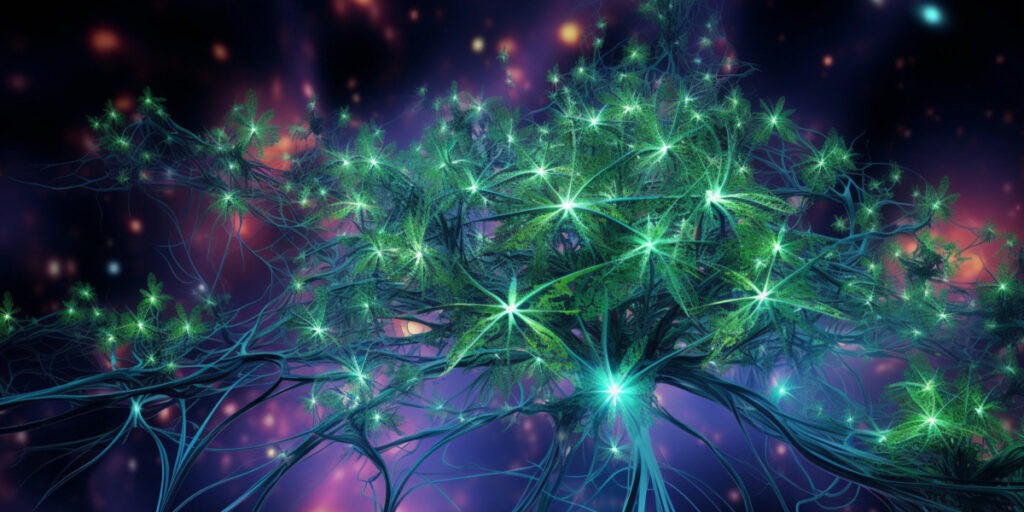The Endocannabinoid System (ECS) is an intricate network of receptors and molecules that affects many aspects of our bodies.
Discovered by Prof. Raphael Mechoulam, the ECS can be activated through medical cannabis to help treat a range of symptoms and diseases.
From regulating the immune system to providing anti-inflammatory properties, learn more about this world-repairing system and the potential benefits of medical cannabis.
Key Takeaways
- The endocannabinoid system exists in all mammals and affects various functions and systems in the body.
- CB1 and CB2 receptors are part of the endocannabinoid system, with CB1 primarily found in the brain and CB2 mainly expressed in cells and organs linked to the immune and blood systems.
- Anandamide, an endocannabinoid found mainly in the brain, is associated with feelings of happiness and joy and increases in response to oxygen deficiency or brain injury.
- The activation of cannabinoid receptors in the body allows for the treatment of symptoms and various diseases, with medical cannabis being used as a treatment or adjunct treatment under the guidance of a specialist doctor and with the necessary legal permissions.
Overview
The endocannabinoid system is a neurotransmitter system that is found in all mammals and affects various functions and systems in the body. Discovered by Prof. Raphael Mechoulam and colleagues, it is composed of cannabinoid receptors, such as CB1 and CB2, and endocannabinoids, such as anandamide (AEA) and AG2.
Endocannabinoids are known to play a role in anxiety levels, depression, nutrition, fetal development, bone strength, and protection. The activation of cannabinoid receptors allows for the therapeutic treatment of symptoms and diseases.
Medical cannabis requires a specialist doctor’s recommendation and a license from the Ministry of Health, and its non-medical use is prohibited. Thus, the potential therapeutic applications of the Endocannabinoid System for mental health are promising.
CB1 and CB2 Receptors
Building on the overview of the Endocannabinoid System, CB1 and CB2 receptors are two essential components of this system. They differ in their locations and functions.
CB1 receptor is primarily found in the brain and is responsible for the anti-inflammatory properties of cannabis.
On the other hand, CB2 receptor is mainly expressed in cells and organs linked to the immune and blood systems. It is highly concentrated in the spleen and involved in the regulation of the immune system.
Both receptors play a critical role in the function of the endocannabinoid system:
- CB1 receptor mediates stress response, pain, and appetite.
- CB2 receptor is important for the regulation of inflammation.
- They also play a role in neuroprotection.
- CB2 receptor function is essential for the maintenance of the immune system.
Understanding the role of these receptors in the endocannabinoid system is a crucial step in harnessing the potential of medical cannabis.
Endocannabinoids
Continuing on from the discussion of CB1 and CB2 receptors, endocannabinoids are naturally occurring compounds found in the body that are involved in the endocannabinoid system.
Anandamide, or AEA, is the most well-known endocannabinoid, which is created by synthesizing arachidonic acid and ethanolamine. It is responsible for feelings of joy and happiness.
AG2, another endocannabinoid, is linked to both CB1 and CB2 receptors and found in the brain and spleen. They play a key role in emotional regulation, influencing anxiety levels, depression, and fetal development.
Endocannabinoids also have effects on appetite and metabolism, making them important for maintaining nutrition.
Medical cannabis can be used to treat symptoms and diseases, but it must be done under the advice of a doctor.
Functions
The endocannabinoid system plays an important role in regulating a variety of bodily functions. These functions include anxiety levels, nutrition, depression, and fetal development. Endocannabinoids have been linked to mental health, bone health, and other aspects of wellbeing.
Anandamide, a naturally occurring endocannabinoid, is associated with feelings of happiness and joy. It is also known to increase in response to oxygen deficiency or brain injury.
AG2, another endocannabinoid, is linked to both CB1 and CB2 receptors and found in the brain and spleen.
The activation of cannabinoid receptors in the body can help with the treatment of symptoms and various diseases. These diseases include inflammation and pain.
Through medical cannabis, it is possible to alleviate symptoms and improve overall health.
Medical Cannabis
Medical cannabis is a viable treatment or adjunct treatment for a variety of ailments, and requires a recommendation from a specialist doctor and a license from the Ministry of Health. There is a wide range of potential side effects and dosage guidelines associated with medical cannabis use, so it is important to consult with authorities and examine each case individually. Cannabis for non-medical purposes is prohibited by law.
| Benefits | Potential Side Effects |
|---|---|
| Anxiety relief | Dry mouth |
| Nutrition aid | Low blood pressure |
| Depression relief | Drowsiness |
| Fetal development | Memory problems |
| Bone protection | Hallucinations |
Benefits
Building on the previously discussed effects of medical cannabis, the endocannabinoid system is responsible for a variety of beneficial effects. It has potential for the treatment of conditions ranging from mental health issues to pain management and more. Exploring the therapeutic potential of the endocannabinoid system could bring relief to many people.
Here are some potential discussion ideas:
- Exploring the therapeutic potential: How the endocannabinoid system benefits mental health
- Unlocking the healing power: The role of the endocannabinoid system in pain management
- CBD and its potential to fight inflammation
- A look at the endocannabinoid system and its role in the immune system
Regulations
Exploring the medical use of cannabis requires an understanding of the regulations surrounding the endocannabinoid system. Legal restrictions are in place to protect the public from potential risks associated with cannabis use. Medical licensing is necessary to ensure that cannabis is used responsibly and safely.
Before considering cannabis for medical treatment, a specialist doctor must provide a recommendation and the patient must obtain a license from the Ministry of Health. It is important to consult with legal authorities and examine the individual case of each patient.
Those who use cannabis for non-medical purposes are in violation of the law and face various legal consequences. The endocannabinoid system offers many benefits when used medicinally, provided it is done so responsibly and with the proper legal permissions.
Frequently Asked Questions
What Other Sources of Endocannabinoids Are There?
In addition to endogenous sources, endocannabinoids can also be derived from plant science. Cannabinoid receptors, such as CB1 and CB2, are activated both by endogenously produced endocannabinoids and those from plant sources. This allows for the therapeutic potential of medical cannabis to be fully realized.
How Do Endocannabinoids Interact With Other Neurotransmitters?
Endocannabinoids interact with other neurotransmitters by helping to maintain a healthy balance. Synthetic cannabinoids may also help to regulate the delicate balance between different neurotransmitters, providing potential therapeutic benefits.
What Are the Long-Term Effects of Using Medical Cannabis?
Medical cannabis can have long-term effects, depending on the frequency and dosage. Risks may include cognitive impairments, addiction, and potential negative interactions with other medications. It is important to discuss the risks with your doctor and practice cannabinoid safety for the best long-term results.
How Do Endocannabinoids Affect the Behavior of Animals?
Endocannabinoids affect animal behavior by influencing neurogenesis and memory formation. This helps animals to learn, remember, and adapt to their environment. Endocannabinoids can also alter mood and behavior, making animals more relaxed or active.
What Are the Most Common Side Effects of Medical Cannabis?
Medical cannabis is known to provide symptom relief, but can also come with side effects. Common ones include drowsiness, dizziness, and changes in appetite due to its interaction with cannabinoid receptors. All individuals should consult their doctor before use.
Conclusion
The Endocannabinoid System is a complex network of receptors and molecules involved in various functions and systems in the body.
Through medical cannabis, the activation of cannabinoid receptors can provide relief from various symptoms and diseases.
However, it is important to consult with authorities and examine individual cases carefully before proceeding with any treatment involving medical cannabis.







